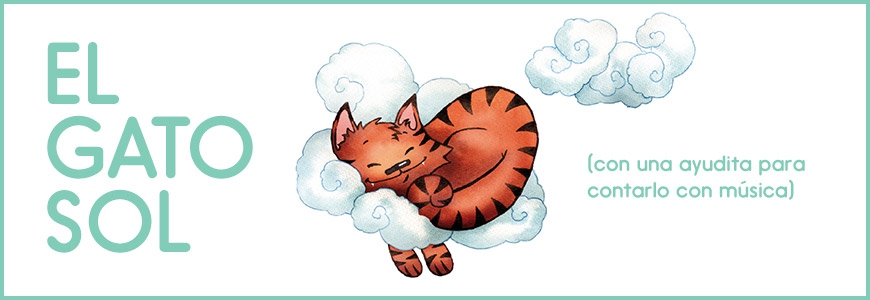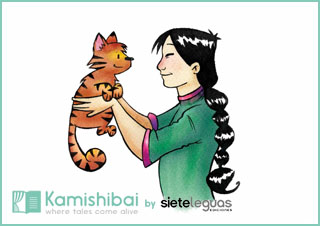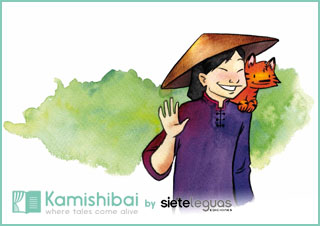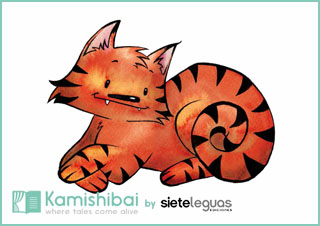
How to tell the Kamishibai story "The Sun Cat" (with music)
Do you think that a Kamishibai storytelling consists only of passing pictures and literally reading the text? Open your mind, leave your comfort zone and have a great time telling "The Sun Cat"! Ready to boost by a 3000% your story and your stage skills? Yeah! Let's go for it!!
Today we're going to show you how to tell the Kamishibai story "The Sun Cat", but in our own special way. A way that usually ends up in great success. But that doesn't mean there aren't as many other ways to tell it, right? All roads lead to Rome!
Many of the tips that we are going to share with you to get the most out of this story, will be useful for all the other Kamishibai stories (except for those that are specific of this story, of course). But there is a part of preparation, tests, etc... that are common to all stories.
And now without any more fuss, let's get into it!
First of all: reading, reading and reading.

To tell this Kamishibai story, it's not necessary that you learn it by heart word for word (which is something that will happen in the end by itself), but it's recommended that you know the story as if you'd written it. And how do you do that? Well, reading!
The more we read The Sun Cat, the deeper we'll get into the story. We could dare to tell the story without ever reading it once, of course. But it's not recommended: we would be leaving too many things to chance and wasting great opportunities to "make the story ours", which ensures that the story moves and is understood.
This way we will really get to communicate the story as if it was something that has happened to us, not as if we were the voice of SIRI that gives us instructions.
We recommend a minimum of three readings, all of them without yet using the Kamishibai PRO Theater (A3).
First reading: simple and quiet.
This is a reading to ourselves, so we will not use our voice yet. The simpler and more focused it is, the more profit we will get out of it. It's not easy, but we should try to restrain the imagination as much as possible. This basically means that if we find ourselves thinking, judging or analyzing what we are reading, we should stop and pick it up later. No thinking about tones, intentions, audience, message... This is not the time. It's just a first approach, simple and quiet.
If you have the Premium version of the story (with storytelling suggestions, music, cutout puppets and mini-cards to reinforce reading comprehension), focus on reading the text only and ignore the suggestions and music changes for the moment.
Second reading: pencil and voice.
Keep a pencil nearby, because now it's time to read The Sun Cat again, but this time out loud. We will identify in which parts we are most fluent and in which parts we are most clumsy. Watch out! Stop all acting impulses. We don't have an audience yet and it's too early to prove anything. So it's not about reading it with different voices, tones, rhythms or anything complex. It's just to hear the words of the story with our own voice. Let's not get too fancy and let's not judge ourselves!
As soon as we make a technical failure (e. g., we get stuck, misread a word, etc.) we will make a small cross at the place of the failure. We will pay attention to these marks later.
Third reading: text-image relationship.
As you know, our Kamishibai stories include in the text side of the storycard the image that is being seen in the theater. In this third reading, we will focus on how the text relates to the illustration that our audience will see. Now is the time to open the door of our imagination.
We will perform this reading out loud. The second an image comes up in our mind, we quickly check that it exists in the illustration. If it does exist, we place it in relation to the viewer. For example, let's start with storycard #02:
A long time ago in a faraway country there was a small humble village that was full of good and happy people.
 We stop because we are sure that some image has already arrived. Let's look at the illustration and compare. What do we see? The faraway country? The humble little village? Good and happy people? What you can clearly see is the small, humble village on the left and a person who lives in fullness on the right. The question, therefore, is: if we were to emphasize just one thing in that sentence, what would it be? From our point of view, what the audience does see. The small humble village. You don't see people.
We stop because we are sure that some image has already arrived. Let's look at the illustration and compare. What do we see? The faraway country? The humble little village? Good and happy people? What you can clearly see is the small, humble village on the left and a person who lives in fullness on the right. The question, therefore, is: if we were to emphasize just one thing in that sentence, what would it be? From our point of view, what the audience does see. The small humble village. You don't see people.
We keep going like this with the rest of the story. When we detect that an image comes up that is not in the illustration, let us think for a moment: would it really be necessary? Or better yet, does that phrase that triggered my imagination matter to the rest of the story? Here is an example on this same story card, number 02:
He taught the little children to add up and take away and he said that he knew the names of all things.
No, that's not on the card. Would it be necessary to see it? Not really, no. So, is it necessary to talk about it? Yes, basically because Voung-Quan will help Tuc-Syn later on to find the proper name for his cat. Therefore, on a strictly narrative level, it is important to communicate that Voung-Quan is a wise man who helps and knows the name of everything.
Take advantage of the blade change to imagine how your audience would react to the new image: what visual information it contains and when the text will explain it (if it does). Surely you will come up with ideas of how to tell the story. It is still a little early to trust them, but don't reject them completely either.
If you have the Premium version of the story, read the narration suggestions to yourselves, understanding them but without following them or giving them any importance yet.
By the end of this third reading, you are likely to be much more familiar with the story than you were at the beginning.
Setting up the rehearsal.

Do you feel ready to tell the story with music in front of an audience? If you have not responded immediately with a categorical "yes", it is time to start rehearsing until you are absolutely sure.
Storytelling elements.
To tell The Sun Cat with music, we'll need:
- Kamishibai PRO Theater (BIG A3)
- The 13 story cards of The Sun Cat.
- The music soundtrack (or access to Spotify, Apple Music, Amazon Music...).
- An MP3 player. It can even be your cell phone, since all tracks are also available on most digital music platforms such as Spotify, Apple Music, Google Play, Amazon, Deezer...
- Some speakers (we recommend a Bluetooth speaker so you don't have any wires).
In our particular way of telling this story, we also use:
- Two cut-out puppets (included in the Premium version).
- The Voung-Quan moustaches (we make them by tying a thread of black wool to a Chinese chop stick).
- A smoking pipe (optional).
- A cloth to cover the Kamishibai Theater.
The table.
Find a stable table. It should be wide enough to fit the theater with its side doors open (minimum 70cm - 27in). Try also how much you would like to open the doors. It is true that if you create an angle (i. e., if you do not open them completely to their fullest extent), you will be "guiding" your audience's attention to the illustration. If you can choose between tables of different heights, choose the highest one. We do not recommend telling the story sitting down unless we have to. It seems silly, but it is very likely that if we sit down, we will make a very impersonal and comfortable "dramatized reading". Standing up will give us energy and will allow us to express ourselves more freely.
Story cards in order.
Check that the story cards are in order. The number of the story card is the one in the lower right corner of the full color face. This step is the most important of all, so never trust anyone but yourselves. Even if someone gives you the cards already ordered and tells you that he has checked it a thousand times.
Sliding out the story cards.
Slinding the story cards is one of the most characteristic actions of the Kamishibai technique. So it's important that you spend a few minutes to figure out what's the best way to do it. No, we are not looking for speed or virtuosity, since that already belongs more to the performance than to the technique itself. For now, let's just find out how to pass the story cards properly almost without looking. We recommend this way that rarely fails:
Put your index and middle fingers together.
Place them between the frame of the theatre and the first story card, so that with your fingernails you touch the wood of the theater and with your fingertips the end of the story card that is visible to the audience.
Move your hand horizontally outwards. The first story card should have attached itself to your fingertips.
If for me reason you see that you are pulling out more than one story card, use your thumb as a stop.
Placing the story card back to the Kamishibai Theater.
In the Kamishibai technique, one of the very few things that has no meaning by itself is placing the story card in the back of the theater. Mostly because it's something strictly technical that is not done at the audience's sight. So, the more agile, quicker and cleaner this gesture is, the more we will focus the attention on what is really important.
Our Kamishibai PRO Theater (BIG A3) is specifically designed to make it as easy as possible for you to place the story card in its back. We do not recommend placing the story card in the same way as you pulled it out, that is, sliding it back in. It requires a lot of attention and precision, and it doesn't always go the way it should. Instead, we recommend this simple technique which is foolproof:
- Insert the entire bottom edge of the story card into the slot in the base of the theater.
- Fold the top of the story card with your thumb until it is fully inserted into the top groove.
Less than a second!
The more you practice these two gestures (the sliding of the story card and putting it back into the theater), the more freedom you will have in your storytelling.
Orchestra in tune.
Check that the sound is working properly. Try technical things like how long it takes for your player to change tracks, where to turn down the volume, how to pause the music, if the screen automatically blocks itself after a few seconds, if the screen has low brightness, how much battery it has, how long it lasts with the battery fully charged, etc. Detect whatever causes you to "get stuck". For example, if you find it difficult to turn up and down the volume, or if changing tracks is complicated, you may need to look for another player. These are two actions that you will do often, so it's best to make things easy.
And don't forget to take a look at the 5 common mistakes made when using music with your Kamishibai. It's so easy to make them!
Ready, set... organization!
Time to get everything ready to begin our storytelling. To do this, close the three theater doors, make sure that the 13 story cards are in order, and place them inside the theater. Have everything ready soundwise, so that when you press "Play" Track 1 plays from the beginning.
Trial... error!

We will start rehearsing with the best possible attitude: by welcoming all difficulties we may face. If you don't find any... be suspicious.
We recommend you to start rehearsing the strictly technical issues and then gradually add your personal touch. Why is that? Because the more you master the storytelling technique, the freer you will feel during the narration.
The first somersault (with a safety net, ok?).
Ready for our first performance of The Sun Cat without an audience? Yes? Awesome! But let's do it first with a safety net: in a "technical" way.
Although we will tell the story from beginning to end, as we said, we will do it in a "technical" way. In other words, we will not look for intentions, changes of rhythm, voices, or anything that has to do with our interpretation. It's simply going through the entire sequence of actions, checking if everything is fine for us.
For example, as it's explained in the Premium version of the story, we start by playing Track 1. After that we open the Kamishibai slowly. We then say, "This story has been told for generations in Vietnam. Hope you like it." And we change the music to Track 2. And finally we pass the story card slowly.
Needless to say, you can do all this in your own way. For example, you can come up with a new introduction ("Do you know where Vietnam is?" or "Can you imagine what would happen if someone called you by a name different from your own?") and keeping the theater closed. Once you've changed to Track 2 and passed to story card 02, then you can open the Kamishibai theater.
The important thing now is to start making these decisions and write them down if necessary.
Great! We're already starting to make the story a little bit more ours.
Another technical rehearsal (yeap, another one).
We're pretty sure that now you're looking forward to diving into the storytelling, trying different voices, using the cut-out puppets that come with the Premium version, and so on.
Check the volume of your voice in relation to the music, realizing how many times you have had to turn it down or up in the middle of your story-telling. Whenever it happens, consider it as a technical failure that you should avoid.
Have you made a mistake in pronouncing any words or sentences? If it matches with a pencil mark we would have made in our second reading, do not hesitate: you need to find other words (more similar to yours) that tell the same story. Don't worry, Julián Fuentes, the author, he won't tell you anything, on the contrary!
Do you have problems passing a card in a particular way? Try to do it in a different, easier way, but beware, don't let it be for convenience. Find a simpler way without distorting the meaning of the way you wanted to pass it.
The festival of decisions.
You have already done two technical rehearsals, so the next thing we should consider is the story's dramaturgy. Excuse me? And what does that mean? Well, we can sum it up in two words: making decisions.
We will tell you how this is done in a practical way. This would be our dramaturgy of The Sun Cat story card by story card:
How to tell The Sun Cat with music (in our own way).
Story card 01:
- Begin with the Kamishibai PRO Theater (BIG A3) closed and placed on a table covered with a cloth, preferably black. The butai would be hidden by a cloth, if possible in a uniform color, different from the cloth covering the table.
- Play Track 1.
- Take advantage of the musical hits to remove the cloth that covers the theater, almost in a magical way. Fold it up and hide it from the audience's sight.
- When the excitement and curiosity go down, aask your audience a few questions:
“Have you ever wondered why you are named after yourselves? And what would happen if someone changed your name?”
Listen to the answers, if any, and continue.
“The story we're about to hear will help us answer those questions. It's a traditional tale from Vietnam, a country in Asia, which has been told for generations and generations, from grandparents to grandchildren, from parents to children. Welcome to the tale of The Sun Cat for the Kamishibai.”
- Play Track 2.
- Pass the story card swiftly.
Story card 02:

- Open the Kamishibai Theater slowly, first the upper door and then the side-doors, these two at the same time if it's possible.
- Begin the storytelling with a normal, calm but not slow narrative rhythm. This is the introduction of Voung-Quan, not a show off of our virtues as gaito kamishibaiya. So we recommend you to avoid the stereotypes of the storyteller who talks to children as if they don't understand anything. Like "A loooong time ago, in a faaar awaaay country...". Words with more vowels than necessary are emphasized words. If we emphasize it's because we believe that what we're telling is important. But you have to hierarchize: not everything is equally important, nor does emphasizing everything guarantees a better understanding and enjoyment. In this introduction of Voung-Quan, the really important thing is to understand that he's a respected wise man in the village and knows the name of all things. Music helps you to create an atmosphere for the story-telling, it is not necessary to illustrate it with more vowels than expected.
- When you get to the end, play Track 3.
- Pass the story card in three steps, matching the hits of the music. That is, slide the story card a little bit (so we'll show the fox), then slide it a little more (and show Tuc-Syn) and finally place it on the back of the theater.
Story card 03:

- The storytelling suggestion invites us to narrate in a "lively, cheerful tone". It's very much in line with the sound of the bird we hear.
- You should begin the narration while placing the story card in the back of the butai. It's better not to wait until the story card is in place. If by any chance you have problems placing it, no one will notice if you have already started talking.
- When you narrate "... so that he could hear the birds sing", try that everyone hears the happy bird that is on his finger. Everything is timed to make it so. If you run out of music, you may be stretching your story-telling too much. Think about whether it's necessary and why. Maybe you're just putting too much emphasis on everything for no special reason.
- When you reach the end, play Track 4.
- Pass the card slightly swinging it, creating a little mystery.
Story card 04:

- As the storytelling suggestion indicates, speaking quietly and creating mystery will help us boost the nightlife we are already creating with the sound.
- Building this atmosphere is important not only because it makes our story-telling more interesting since it's richer in details, but also because it really helps to understand the whole story. At this moment, the first great event of the story takes place, and it's the origin of all the conflict that will follow: the beginning of a great friendship.
- As you will notice, soundwise there is no music as in the previous story cards, just the sound of some crickets and some slight hum. This is to help you create a better atmosphere of mystery and loss.
- When you reach the end, play Track 5.
- Pass the story card quickly, to help the audience get out of that atmosphere you've created.
Story card 05:

- You should start the storytelling as soon as possible, even if you have not yet finished passing the entire sheet. For this, we recommend that you learn the first sentence by heart: “Así, el gato se quedó a vivir con Thuc”. This way, we will get out of that mysterious and nocturnal atmosphere and we will imply that some time has passed, something that is clearly seen by the size of Cat.
- The music is now a soft, simple melody, played by a single instrument, which sounds over some birds in the background. Careful, don't let it catch you. The idea is to create a friendly atmosphere, but very simple, without greater complications. Let the music express this, not you. Focus on telling how much fun they had together and how many things they shared
- We now come to Thuc's reflection. This is the first time we're going to give voice to a character that it's not ourselves. It is convenient to choose a characteristic voice, which distinguishes itself a little from our voice as storytellers. Make it easy to maintain and remember.
- We should do the reflection without music. If all goes well, right at this very moment, a silence will have been created. It has two purposes: on the one hand, it helps us to contrast with that feeling of simplicity that music was creating for us and on the other, it reinforces the idea of Thuc's self-absorption. This reflection is the origin of all complications, so the more brainy you are, the better they'll understand everything that's to come.
- When you reach the end, play Track 6.
- Pass the story card quickly.
Story Card 06:

- Just like in the previous story card, we should start the storytelling as soon as possible.
- We like to think of this card as a journey. That's why the music has that dynamic and travelling mood, while keeping its Vietnamese style. It's meant to enhance Thuc's decision. Now, the music has a slight melancholic touch on purpose. It's not intended to emphasize the fact that Thuc has come up with the solution to his problems and embarks on a fantastic journey, basically because that's not true. It implies that he is actually walking to a place where he will have to reflect on everything he believes in at this time.
- If you want you can improvise something of your own concerning the trip. In this moment we love to break all the two-dimensional rules and walk with our index and middle fingers over the theater, while describing typical Vietnamese animals that come across Thuc and Cat. The music lasts a little longer than expected so that, if you want, you can add something that makes your story unique.
- In the Premium version you also get a cut-out puppet of Thuc and Cat. Instead of walking with your two fingers over the theater, you can use it for the same purpose: breaking the two dimensions of the theater. It might come as a surprise, just before: "Thuc arrived with Gato on his shoulder, as usual".
- Voung-Quan makes its first appearance as antagonist in this card. However, we don't see him in the theater yet. What can we do about it? In addition to finding different voices for the different characters, we like to use many more resources to characterize them. Stop! Before you rush to get a makeup case, we tell you how we make Thuc different from Voung-Quan: when we talk like Thuc we always do it on sight of the audience, but when we talk like Voung-Quan, we hide completely behind the theater, showing only our hand, which moves like Voung-Quan's hand when speaking. Thuc will thus be portrayed as an agile and intrepid young man, and Voung-Quan as a respected and somewhat enigmatic wise man. Easy and effective, huh?
- If you're going to use the cut-out puppet of Cat on Thuc's shoulders and you like the idea that the only thing seen of Voung-Quan is his hand, then you shouldn't doubt it: hidden behind the theater and with the puppet in the audience's sight, pet Cat lovingly, as you would be telling it.
- When you reach the end, play Track 7.
- If your Voung-Quan is only one hand, stay hidden behind the butai.
- This track is just three hits of crotals. Use them to make the elements disappear one by one: first hit, the puppet disappears; second hit, slide a little bit the card; third hit, slide the card completely until you fully show the following card.
Story Card 07:

- You should find a voice for Voung-Quan that suggests wisdom, sympathy and humility.
- As we told you in the previous illustration, when we speak as the wise man we hide completely behind the theater and only show the right hand, which we move in harmony with the speeches of Voung-Quan.
- To speak as Thuc-Syn. Hide your hand and jump out completely from behind the theater. Get back to the voice you had chosen for him.
- Likewise, hide when you're going to speak as Voung-Quan. If you can also get a pipe, this would be the time to pull it out.
- When you're done, play Track 8.
- Hide the hand that has the pipe and slide the card quickly.
Story Card 08:

- Try to get out from behind the theater as quickly as possible, while saying "Sun".
- As you can imagine, in Voung-Quan's reply you should disappear and take your hand out with the pipe. If the pipe is too much of a burden for you or makes the changes between characters not smooth, do not use it at all.
- From now on, sound and music will play two different roles: on one hand, it acts as a comic counterpoint. We will always listen to Cat first (whimpering, purring, whining...). On the other hand, all the musics will be the same melody versioned in different ways, to imply that, no matter how much the music is "disguised", it is actually the same melody. Just like the different names Thuc wants to give to Cat.
- When you reach the end, play Track 9.
- Pass the story card quickly after hearing the small meowing sound.
Story Card 09:
- It's a very similar card to the previous one, so you should follow the same sequence: in sight when Thuc speaks, hidden behind the theater and showing your hand when Voung-Quan speaks.
- When you reach the end, play Track 10.
- Pass the story card quickly after hearing the cat meow.
Story Card 10:
- The beginning of this card would be the same as the previous one: poping up as Thuc when he gives the name "Wind" to Cat.
- You should have Cat's cutout puppet well located. If so, hide once more!
- The puppet of Cat should appear along with "Meanwhile, Cat was playing with Voung-Quan...". What we usually do is holding the puppet with one hand and with the other (Voung-Quan's hand) play a little game with Cat. Make sure that Cat plays with Voung-Quan's hand and not the other way around. A couple of simple touches should be enough.
- When you reach the end, hide Voung-Quan's hand and play Track 11 with the puppet still in sight.
- Hide the puppet with the meow.
- Pass the slide swiftly as you hear the stroke of the gong.
Story Card 11:
- Continue the same pattern as in the previous story cards: show yourself when Thuc speaks and hide when Voung-Quan does.
- When you reach the end, play Track 12.
- We pass the story card swaying it, following the rhythm of the music.
Story Card 12:
- That's right! Continue to show yourself to the audience when you speak as Thuc and disappear when the wise Voung-Quan speaks.
- This story card ends with the storyteller saying: "Thuc thought for a moment and said:". You should say this sentence standing up in the audience's sight.
- When finished, play Track 13.
- Pass the story card slowly.
Story Card 13:

- You're already standing up, so you're Thuc Syn. ;)
- Now that Thuc Syn has found the right name for his cat, it's time to show Voung-Quan's face. Keep the chopstick with the thread of black wool close, that is to say, the mustaches of the wise man. Maybe the best thing is that his first sentence ("True, young Thuc") you say it like the rest, hidden behind the theater. This way you could easily grab the stick and hold it in a way that it looks like your whiskers. Once you are ready (do not delay too long) come out slowly as you tell Thuc that 'Cat' was indeed the best name for Cat. All this final reflection can be done by stroking your whiskers, they love it.
- It's important that you end the story looking them in the eyes in a relaxed way, being aware of not loosing Voung Quan's character but at the same time not performing actions that could distract too much.
- We love to end up by taking off our whiskers and saying "And this was the story of The Sun Cat for the Kamishibai" as we close the theater doors.
Enjoy yourselves!
All this doesn't make sense if you don't tell the story to someone. So, now that you know one of the many ways to tell The Sun Cat, it's time to set up an audience session and see what happens. Will they boo you? Will they throw tomatoes at you? Will they tell you that "I'm bored" or "I didn't understand anything"? We doubt it very much. But very, very, veeeeery much. (Now, that's emphasized). :)
Do you tell the story of The Sun Cat differently? Share it with the rest of gaitos kamishibaiya by leaving a comment below, we're looking forward to discovering your version! And if you have found something of value in this article, don't forget to share it and I like it: nothing motivates us more to continue spreading our passion for Kamishibai.
See you in our next article!
Deja un comentarioDa una respuesta
Blog categories
Archivo del blog
Buscar
Últimos comentarios
Fabiana BEGAUD
en How to illustrate a Kamishibai PRO DIY story...claudine legac
en Got a new website, blog and many renewed hopes!claudine legac
en How to tell the Kamishibai story "The Sun Cat"...Nicole MIKOLAJEK
en What would you do if you had a Kamishibai?...







1 Comentario
claudine legac 29/03/2020
If one day you need to translate some texts from English to French I could help you ...Claudine Le Gac; just tell me;;;